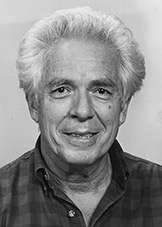Harold W. Kuhn
| Harold W. Kuhn | |
|---|---|
 | |
| Born |
July 29, 1925 Santa Monica, California |
| Died |
July 2, 2014 (aged 88) New York City, New York |
| Residence | United States |
| Nationality | American |
| Fields | Mathematics |
| Institutions | Princeton University |
| Alma mater | Princeton University |
| Doctoral advisor | Ralph Fox |
| Doctoral students |
James G. MacKinnon Guillermo Owen Richard Stearns |
| Known for |
Hungarian method Karush–Kuhn–Tucker conditions Kuhn poker |
| Notable awards | John von Neumann Theory Prize (1980) |
Harold William Kuhn (July 29, 1925 – July 2, 2014) was an American mathematician who studied game theory. He won the 1980 John von Neumann Theory Prize along with David Gale and Albert W. Tucker. A former Professor Emeritus of Mathematics at Princeton University, he is known for the Karush–Kuhn–Tucker conditions, for Kuhn's theorem, for developing Kuhn poker as well as the description of the Hungarian method for the assignment problem. Recently, though, a paper by Carl Gustav Jacobi, published posthumously in 1890 in Latin, has been discovered that anticipates by many decades the Hungarian algorithm.[1][2]
Life
Kuhn was born in Santa Monica in 1925.[3] He is known for his association with John Forbes Nash, as a fellow graduate student, a lifelong friend and colleague, and a key figure in getting Nash the attention of the Nobel Prize committee that led to Nash's 1994 Nobel Prize in Economics.[4] Kuhn and Nash both had long associations and collaborations with Albert W. Tucker, who was Nash's dissertation advisor. Kuhn co-edited The Essential John Nash,[5] and is credited as the mathematics consultant in the 2001 movie adaptation of Nash's life, A Beautiful Mind.[6]
Harold Kuhn served as the third president of the Society for Industrial and Applied Mathematics (SIAM).
His oldest son was historian Clifford Kuhn (1952-2015), noted for his scholarship on the American South and for collecting oral history. Another son, Nick Kuhn, is a professor of mathematics at the University of Virginia.[7] His youngest son, Jonathan Kuhn, is Director of Art and Antiquities for the New York City Department of Parks & Recreation.
Kuhn died on July 2, 2014.[8]
Bibliography
- Kuhn, H. W. (1955). "The Hungarian method for the assignment problem". Naval Research Logistics Quarterly. 2: 83–97. doi:10.1002/nav.3800020109.
- Republished; Kuhn, H. W. (2005). "The Hungarian method for the assignment problem". Naval Research Logistics. 52 (1): 7–21. doi:10.1002/nav.20053.
- Guillermo Owen (2004) IFORS' Operational Research Hall of Fame Harold W. Kuhn International Transactions in Operational Research 11 (6), 715–718. doi:10.1111/j.1475-3995.2004.00486.
- Kuhn, H.W. "Classics in Game Theory." (Princeton University Press, 1997). ISBN 978-0-691-01192-9.
- Kuhn, H.W. "Linear Inequalities and Related Systems (AM-38)" (Princeton University Press, 1956). ISBN 978-0-691-07999-8.[9]
- §Ganesh, H.W. "Contributions to the Theory of Games, I (AM-24)." (Princeton University Press, 1950). ISBN 978-0-691-07934-9.[10]
- Kuhn, H.W. "Contributions to the Theory of Games, II (AM-28)." (Princeton University Press, 1953). ISBN 978-0-691-07935-6.[11]
- Kuhn, H.W. "Lectures on the Theory of Games." (Princeton University Press, 2003). ISBN 978-0-691-02772-2.
- Kuhn, H.W. and Nasar, Sylvia, editors. "The Essential John Nash." (Princeton University Press, 2001). ISBN 978-0-691-09527-1.
References
- ↑ Ollivier, F.; Sadik, B. (2007). "La borne de Jacobi pour une diffiete' definie par un systeme quasi regulier". Comptes Rendus de l'Academie des Sciences de Paris. 345 (3): 139–144. doi:10.1016/j.crma.2007.06.010.
- ↑ Harold W. Kuhn, The Hungarian Method for the Assignment Problem and how Jacobi beat me by 100 Years, Seminar, Concordia University, September 12, 2006
- ↑ Siegfried Gottwald, Hans J. Ilgauds, Karl H. Schlote (Hrsg.): Lexikon bedeutender Mathematiker. Verlag Harri Thun, Frankfurt a. M. 1990 ISBN 3-8171-1164-9
- ↑ The Times Higher Education Supplement: The autumnal sadness of the Princeton ghost
- ↑ The Essential John Nash, edited by Harold W. Kuhn & Sylvia Nasar, Princeton University Press
- ↑ Harold Kuhn, consultant: Princeton
- ↑ Nick Kuhn, Professor of Mathematics, Department of Mathematics, University of Virginia
- ↑ "Professor Emeritus Harold W. Kuhn died on July 2, 2014". math.princeton.edu. July 3, 2014.
- ↑ Motzkin, Theodore S. (1957). "Review: H. W. Kuhn and A. W. Tucker, Linear inequalities and related systems". Bull. Amer. Math. Soc. 63 (3): 202–203. doi:10.1090/s0002-9904-1957-10103-7.
- ↑ Wolfowitz, J. (1951). "Review: Contributions to the theory of games, Vol. 1, ed. H. W. Kuhn and A. W. Tucker". Bull. Amer. Math. Soc. 57 (6): 495–497. doi:10.1090/s0002-9904-1951-09550-6.
- ↑ Wolfowitz, J. (1954). "Review: Contributions to the theory of games, Vol. 2, ed. H. W. Kuhn and A. W. Tucker" (PDF). Bull. Amer. Math. Soc. 60 (1): 90–92. doi:10.1090/s0002-9904-1954-09766-5.
External links
- Harold W. Kuhn at the Mathematics Genealogy Project
- Princeton University Press: The Essential John Nash
- Collaboration with George Dantzig
- biography of Harold Kuhn from the Institute for Operations Research and the Management Sciences